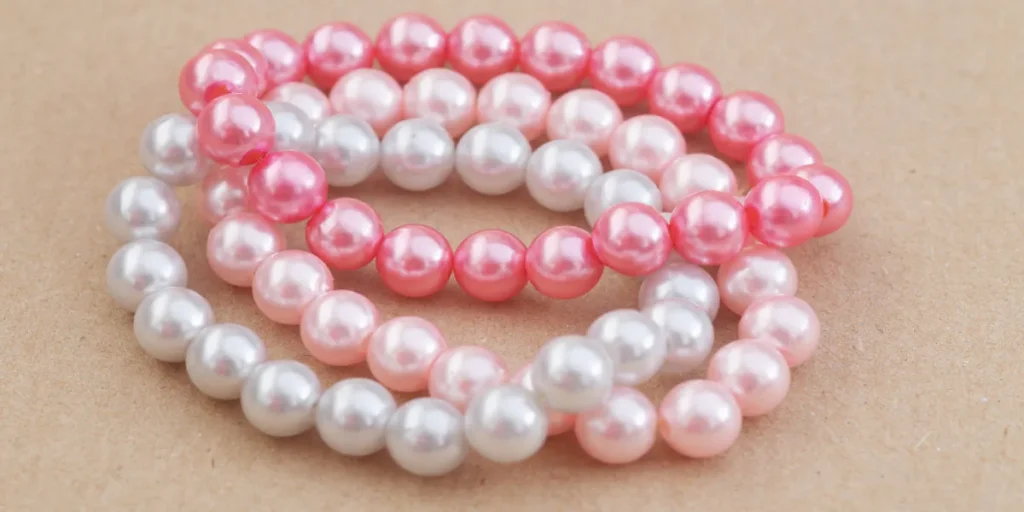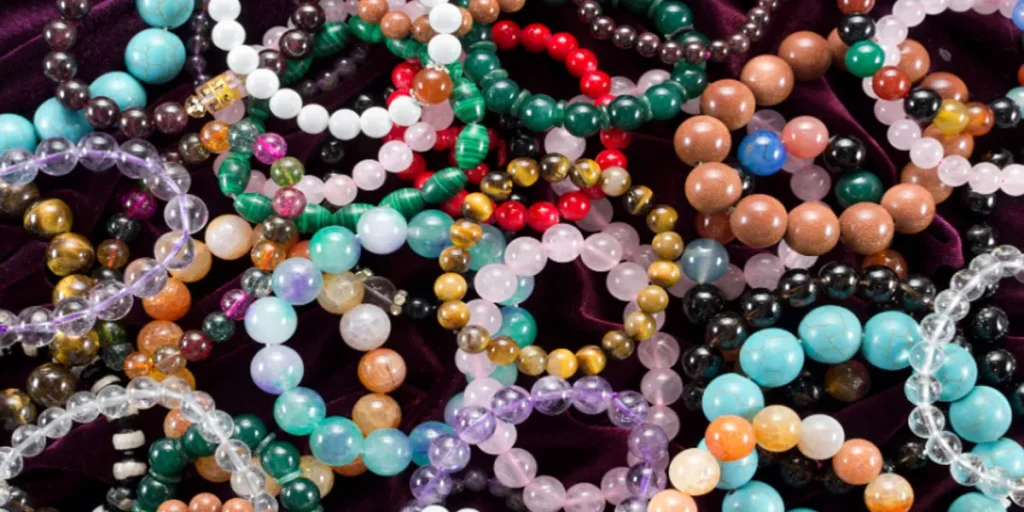A typical bracelet weighs between 10 to 200 grams. The weight varies based on the material and design of the bracelet.
Bracelets are fashion staples that come in various styles and materials, each with a distinct weight that contributes to its wearability and comfort.
They can range from delicate, lightweight chains under 10 grams to heavier statement pieces adorned with gems and metals that may exceed 200 grams.
The choice of bracelet can be a personal statement, reflecting one’s style and the occasion for which it is worn.
Silver, gold, leather, and beaded bracelets add diverse options for both men and women, promising a perfect fit for everyone’s taste and wardrobe.
Understanding the weight is crucial not only for comfort but also for assessing quality and durability.
When selecting a bracelet, consider the weight as an important factor to ensure it complements your daily activities without causing discomfort or inconvenience.
Weights Of Bracelets: A Jewel’s Tale
The weight of a bracelet can tell a story of its craft, materials, and use. From delicate charms to robust bangles, each piece has its signature heft.
In this story of grams and ounces, we unveil the journey behind the weight of these ornamental wonders.
Find out what factors affect the mass of bracelets and the average weights you can expect across various types.
Factors Influencing Bracelet Weight
Different components mold the weight of a bracelet.
- Material: Gold is heavier than silver.
- Size: Larger bracelets weigh more.
- Design: Complex patterns can be heavier.
- Gemstones: Diamonds add extra weight.
- Thickness: Thicker bracelets have more mass.
Average Weights By Bracelet Type
Bracelets come in all shapes and sizes. Each type has a common weight range.
| Bracelet Type | Average Weight |
|---|---|
| Charm | 15-50 grams |
| Bangle | 10-100 grams |
| Link | 25-70 grams |
| Cuff | 30-200 grams |
| Tennis | 20-60 grams |
These numbers offer a glimpse into the standard weights for each bracelet category. The actual weight of an individual bracelet can vary based on several factors.
Material Matters: Gold, Silver, And Beyond

Wondering how much that shiny bracelet on your wrist weighs? The answer lies in what it’s made of. Different materials mean different weights.
Gold and silver are popular, but there are more options out there. Let’s dive into the world of precious metals and alternative materials to see how they affect your bracelet’s weight.
The Heft Of Precious Metals
Gold and silver bracelets feel heavier than they look.
- Gold is dense, adding more weight to the design.
- Silver is lighter than gold, but still has noticeable heft.
These metals are measured in grams or ounces.
| Material | Typical Weight Range |
|---|---|
| Gold (14k) | 5 to 100 grams |
| Silver (925 sterling) | 10 to 50 grams |
Alternative Materials And Their Impact On Weight
Not all bracelets are metal. Some use lighter materials.
- Beads can be glass, plastic, or stone.
- Leather is much lighter than metal.
- Silicone or rubber makes for feather-light bracelets.
These materials change the weight significantly. A silicone band might weigh less than 5 grams! Here’s a quick comparison:
| Material | Average Weight |
|---|---|
| Beaded (Glass) | 15 to 30 grams |
| Leather | 10 to 20 grams |
| Silicone | < 5 grams |
Design And Dimension: The Weight Equation

Ever wondered why bracelets come in different weights? It’s not just about the material. Design and dimension play a crucial role.
A delicate chain bracelet can be as light as a feather. A chunky bangle might feel like lifting a small dumbbell.
Let’s dive into the fascinating world of bracelet weights and what really tips the scales.
Influence Of Bracelet Design On Weight
Design greatly affects weight. Imagine two bracelets. Both are gold, but one is a thin chain, and the other a broad cuff.
Despite the same material, the cuff is heavier. Why? It’s simple: more gold equals more weight.
Different design elements include:
- Chain width – Thicker chains weigh more.
- Charms and adornments – Gems and beads add grams.
- Closure types – A large clasp can tip the scale.
Measuring The Weight Of Custom Designs
To find the weight of a custom bracelet, start with consulting the creator. They often know the specifics.
If it’s a DIY project, a digital scale can give exact numbers. Place the bracelet on the scale, and note the weight. Easy!
A typical bracelet weight ranges from:
| Bracelet Type | Average Weight |
|---|---|
| Thin Chain | 1-5 grams |
| Beaded Bracelet | 15-50 grams |
| Chunky Bangle | 75-200 grams |
Bracelet Weights Across Cultures
Bracelets have adorned wrists across the world for centuries. They come in various forms, from simple bands to intricate designs.
The weight of a bracelet can tell a story of its cultural significance, the era it’s from, and the materials used. Let’s explore how bracelet weights differ across cultures and times.
Traditional Heavyweight Bracelets
Historically, bracelets served as symbols of wealth and status. In many cultures, the heavy weight of a bracelet was associated with power and affluence.
Communities worldwide crafted these pieces from dense materials, often reflecting their cultural heritage.
- Gold and Silver: Often weighing over 100 grams, these bracelets were substantial in both weight and value.
- Stone and Beads: Mayan civilization used dense stones, resulting in bracelets that could weigh as much as 200 to 300 grams.
- Wood and Metal: African tribes favored wood and metal combinations, reaching weights up to 500 grams.
Modern Lightweight Trends
Today’s fashion leans towards minimalism and comfort. Lightweight bracelets reflect contemporary tastes and active lifestyles. Advances in technology allow for durable yet airy materials.
- Aluminum and Titanium: Popular for their strength-to-weight ratio, resulting in pieces as light as 10 to 50 grams.
- Plastic and Silicone: Ideal for casual wear, and hardly felt on the wrist, weighing between 5 to 20 grams.
- Thin Gold and Silver: Elegance without the heft, trendy thin bracelets stay below 25 grams.
| Material | Culture | Average Weight |
|---|---|---|
| Gold/Silver | Global | 100g+ |
| Stone/Beads | Mayan | 200-300g |
| Wood/Metal | African | Up to 500g |
| Aluminum/Titanium | Modern | 10-50g |
| Plastic/Silicone | Modern | 5-20g |
| Thin Gold/Silver | Modern | <25g |
The tale of bracelets is one of constant evolution. From the heavy, opulent adornments of ancient times to the sleek, featherlight accessories of today, these jewelry pieces capture the essence of their eras.
Whether a statement of cultural identity or a testament to modern innovation, the weight of a bracelet is a fascinating chapter in the story of human adornment.
When Weight Becomes Crucial?
Wearing Comfort: When Weight Becomes Crucial is more than just a phrase for bracelet enthusiasts. The perfect bracelet merges style with comfort, turning an accessory into a constant companion.
Whether layering bracelets for a statement look or choosing a simple piece for everyday wear, the weight plays a pivotal role in comfort and practicality.
The Role Of Weight In Bracelet Selection
Selecting the right bracelet is about finding balance. A bracelet’s weight can influence not only the comfort but also the durability and wearability of the piece.
Heavier bracelets may showcase quality and luxury, yet they could also lead to discomfort over time.
Lighter pieces, on the other hand, promise ease and subtlety. Here are some key points:
- Material Matters: Gold weighs more than silver, and beads are lighter than metals.
- Design Impact: Intricate designs often add weight due to additional materials.
- Comfort is Key: The ideal weight feels good on your wrist all day.
Weight Considerations for Daily Wear vs. Occasional Pieces
Weight Considerations For Daily Wear Vs. Occasional Pieces
Different occasions call for different bracelet styles and weights. Here’s a quick guide to help you decide:
| Daily Wear | Occasional Wear |
|---|---|
| Lightweight for comfort and functionality. | Bolder weights for a standout look. |
| Minimalistic designs that blend seamlessly with routine. | Luxurious and flamboyant designs for events. |
| Materials such as leather, cotton, or thin chains. | Heavier metals and embellishments for impact. |
Remember, the right weight for a bracelet can increase wear time and enhance your overall experience.
Whether light and delicate for the day or heavy and ornate for the night, choose wisely to ensure maximum comfort and style.
The Price-weight Relationship
The weight of a bracelet can deeply impact its value. This holds especially true in the jewelry market where the worth of a piece often hinges on both its craftsmanship and material weight.
Pricing For Different Weights
Bracelets come in various weights and materials, leading to a diverse range of prices. A gold bracelet can be substantially heavier and more expensive than one made from beads. Sellers price these items based on current market rates, which fluctuate regularly.
| Material | Average Weight Range | Estimated Price per Gram |
|---|---|---|
| Silver | 5-100 grams | $0.50 – $0.80 |
| Gold | 3-150 grams | $30 – $50 |
| Plastic/Beads | 2-50 grams | $0.10 – $0.30 |
Estimating The Value: Tools And Tips
To estimate a bracelet’s weight, use a jewelry scale. Digital scales offer the most precise measurements, essential for determining a piece’s worth.
- Check the purity of the material, like 14K or 24K for gold.
- Look up the current market price for the material per gram or ounce.
- Calculate the value by multiplying weight by the market price.
- Consider craftsmanship, which can add significant value.
Online calculators can simplify this process by automating the calculations, factoring in both weight and purity to produce an estimate.
FAQ About the Weight of a Bracelet
What Is The Average Weight Of A Bracelet?
Typically, the average weight of a bracelet varies widely. Depending on the material, a simple silver bracelet may weigh around 5-15 grams.
More elaborate designs, or those made from heavier metals like gold, could be anywhere from 20 to over 100 grams.
Does Bracelet Weight Affect Its Value?
Yes, the weight of a bracelet can impact its value, particularly for bracelets made of precious metals like gold or platinum.
Heavier bracelets contain more material, which often correlates to a higher cost. However, craftsmanship and design also heavily influence value.
Are Heavier Bracelets More Durable?
Heavier bracelets are often more durable due to the use of more metal in their construction, which can reinforce their structure.
However, durability also depends on the type of metal and quality of craftsmanship.
How To Measure The Weight Of Your Bracelet?
To measure a bracelet’s weight, place it on a digital jewelry scale ensuring it’s calibrated to zero.
For an accurate measurement, ensure that the bracelet is free of any debris or attached charms that aren’t part of its original weight.
Conclusion
Wrapping up our discussion on bracelet weights, it’s evident that factors like material and design are key.
Whether it’s a dainty chain or a chunky bangle, understanding these aspects ensures a perfect choice for your style and comfort.
Keep this info handy the next time you’re jewelry shopping, and you’ll make an informed selection every time.
Resources:
https://www.nasa.gov/stem-content/make-a-binary-bracelet/
